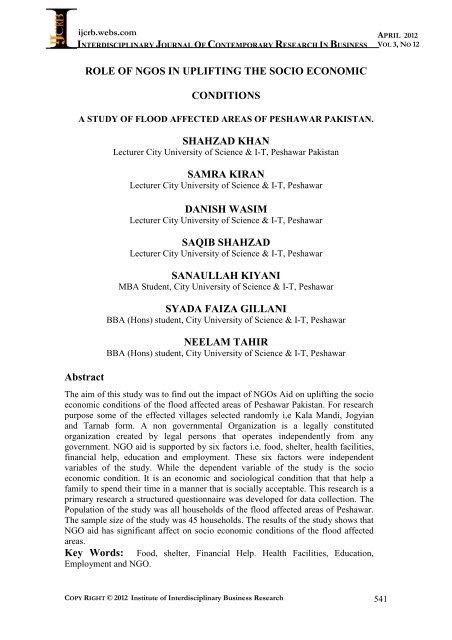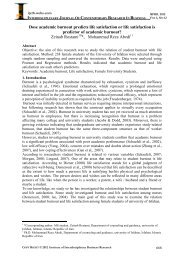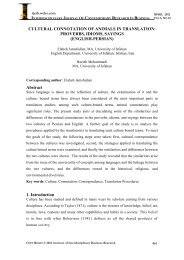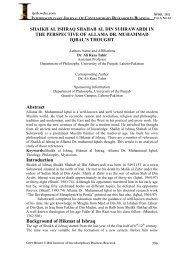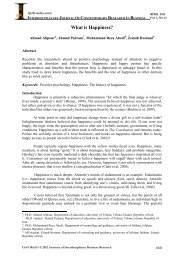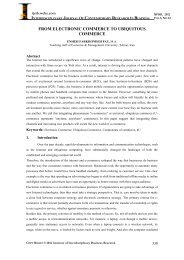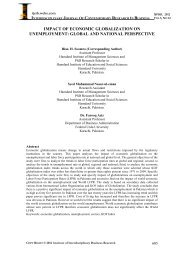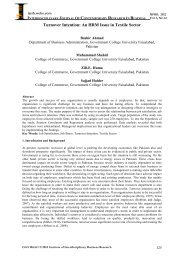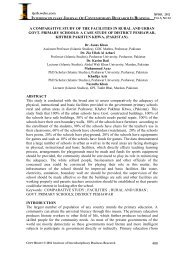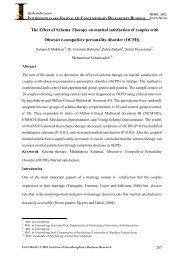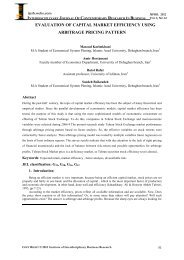role of ngos in uplifting the socio economic conditions - journal ...
role of ngos in uplifting the socio economic conditions - journal ...
role of ngos in uplifting the socio economic conditions - journal ...
You also want an ePaper? Increase the reach of your titles
YUMPU automatically turns print PDFs into web optimized ePapers that Google loves.
ijcrb.webs.com<br />
INTERDISCIPLINARY JOURNAL OF CONTEMPORARY RESEARCH IN BUSINESS<br />
APRIL 2012<br />
VOL 3, NO 12<br />
ROLE OF NGOS IN UPLIFTING THE SOCIO ECONOMIC<br />
CONDITIONS<br />
A STUDY OF FLOOD AFFECTED AREAS OF PESHAWAR PAKISTAN.<br />
Abstract<br />
SHAHZAD KHAN<br />
Lecturer City University <strong>of</strong> Science & I-T, Peshawar Pakistan<br />
SAMRA KIRAN<br />
Lecturer City University <strong>of</strong> Science & I-T, Peshawar<br />
DANISH WASIM<br />
Lecturer City University <strong>of</strong> Science & I-T, Peshawar<br />
SAQIB SHAHZAD<br />
Lecturer City University <strong>of</strong> Science & I-T, Peshawar<br />
SANAULLAH KIYANI<br />
MBA Student, City University <strong>of</strong> Science & I-T, Peshawar<br />
SYADA FAIZA GILLANI<br />
BBA (Hons) student, City University <strong>of</strong> Science & I-T, Peshawar<br />
NEELAM TAHIR<br />
BBA (Hons) student, City University <strong>of</strong> Science & I-T, Peshawar<br />
The aim <strong>of</strong> this study was to f<strong>in</strong>d out <strong>the</strong> impact <strong>of</strong> NGOs Aid on uplift<strong>in</strong>g <strong>the</strong> <strong>socio</strong><br />
<strong>economic</strong> <strong>conditions</strong> <strong>of</strong> <strong>the</strong> flood affected areas <strong>of</strong> Peshawar Pakistan. For research<br />
purpose some <strong>of</strong> <strong>the</strong> effected villages selected randomly i,e Kala Mandi, Jogyian<br />
and Tarnab form. A non governmental Organization is a legally constituted<br />
organization created by legal persons that operates <strong>in</strong>dependently from any<br />
government. NGO aid is supported by six factors i.e. food, shelter, health facilities,<br />
f<strong>in</strong>ancial help, education and employment. These six factors were <strong>in</strong>dependent<br />
variables <strong>of</strong> <strong>the</strong> study. While <strong>the</strong> dependent variable <strong>of</strong> <strong>the</strong> study is <strong>the</strong> <strong>socio</strong><br />
<strong>economic</strong> condition. It is an <strong>economic</strong> and <strong>socio</strong>logical condition that that help a<br />
family to spend <strong>the</strong>ir time <strong>in</strong> a manner that is socially acceptable. This research is a<br />
primary research a structured questionnaire was developed for data collection. The<br />
Population <strong>of</strong> <strong>the</strong> study was all households <strong>of</strong> <strong>the</strong> flood affected areas <strong>of</strong> Peshawar.<br />
The sample size <strong>of</strong> <strong>the</strong> study was 45 households. The results <strong>of</strong> <strong>the</strong> study shows that<br />
NGO aid has significant affect on <strong>socio</strong> <strong>economic</strong> <strong>conditions</strong> <strong>of</strong> <strong>the</strong> flood affected<br />
areas.<br />
Key Words: Food, shelter, F<strong>in</strong>ancial Help. Health Facilities, Education,<br />
Employment and NGO.<br />
COPY RIGHT © 2012 Institute <strong>of</strong> Interdiscipl<strong>in</strong>ary Bus<strong>in</strong>ess Research 541
ijcrb.webs.com<br />
INTERDISCIPLINARY JOURNAL OF CONTEMPORARY RESEARCH IN BUSINESS<br />
APRIL 2012<br />
VOL 3, NO 12<br />
Introduction<br />
Earth's is our home planet made up <strong>of</strong> different elements and parts like land, air, water<br />
and life. There always occur some changes which may be natural or caused by humans.<br />
These natural changes some time causes hazardous event <strong>in</strong> shape <strong>of</strong> natural disasters. A<br />
disaster is a natural or man-made hazard that causes heavy damages <strong>in</strong> shape <strong>of</strong><br />
physical, human, material or environmental losses that go beyond <strong>the</strong> ability <strong>of</strong> <strong>the</strong><br />
effected society to cope us<strong>in</strong>g its own scarce resources. A natural disaster is <strong>the</strong><br />
consequence or effect <strong>of</strong> a hazardous event, occurr<strong>in</strong>g when a physical event <strong>of</strong> natural<br />
phenomenon, such as a volcanic eruption, earthquake, landslide, storms and floods<br />
become unprecedented and enmeshed.<br />
Dur<strong>in</strong>g <strong>the</strong> third week <strong>of</strong> July (2010), many parts <strong>of</strong> Pakistan were struck with a natural<br />
disaster, <strong>the</strong> scale <strong>of</strong> which was unprecedented for <strong>the</strong> country. It made approximately<br />
20 million people homeless and killed over 2000 people. Accord<strong>in</strong>g to a UN report<br />
(2010) <strong>the</strong> flood caused a damage <strong>of</strong> $9.7 billion. The country’s agricultural sector has<br />
been adversely hit caus<strong>in</strong>g a massive decrease <strong>in</strong> <strong>the</strong> exports for <strong>the</strong> year and thus<br />
decreas<strong>in</strong>g national <strong>in</strong>come substantially for <strong>the</strong> already f<strong>in</strong>ancially burdened country.<br />
Accord<strong>in</strong>g to a report <strong>of</strong> Geo TV Network <strong>in</strong> 2010, by <strong>the</strong> end <strong>of</strong> march 2010 public<br />
debt <strong>of</strong> Pakistan reached to an enormous amount i.e., Rs. 8.160 that is equivalent to 56<br />
% <strong>of</strong> GDP and 379 % <strong>of</strong> aggregate budgeted revenue. Of greater concern are <strong>the</strong><br />
negative effects that this calamity will have carried forward to <strong>the</strong> country’s subsequent<br />
f<strong>in</strong>ancial years. To m<strong>in</strong>imize this negative impact, on <strong>the</strong> country’s follow<strong>in</strong>g f<strong>in</strong>ancial<br />
years, <strong>of</strong> most critical importance is <strong>the</strong> early rehabilitation <strong>of</strong> <strong>the</strong>se areas and people,<br />
and <strong>the</strong> restoration <strong>of</strong> <strong>the</strong>ir productivity as soon as possible.<br />
The flood has brought with it a new wave <strong>of</strong> an even more severe level <strong>of</strong> poverty, for<br />
<strong>the</strong>se already impoverished areas. And thus also threatens <strong>the</strong> wellbe<strong>in</strong>g <strong>of</strong> <strong>the</strong> victims<br />
and not just <strong>the</strong>ir and <strong>the</strong> economy’s productivity. NGO`s has been empirically proven<br />
to be effective <strong>in</strong> contribut<strong>in</strong>g <strong>the</strong> ris<strong>in</strong>g <strong>of</strong> <strong>socio</strong> <strong>economic</strong> condition, especially <strong>in</strong> <strong>the</strong><br />
flood affected areas, and to overall society, especially at <strong>the</strong> village level NGO`s helps<br />
both <strong>the</strong> poor participants and <strong>the</strong> local economy.<br />
While conduct<strong>in</strong>g this study to identify “Role <strong>of</strong> NGO`s <strong>in</strong> Uplift<strong>in</strong>g <strong>the</strong> Socio-<br />
Economic Conditions <strong>of</strong> Flood Affected Areas <strong>in</strong> Peshawar” for this purpose different<br />
affected villages selected randomly. Research f<strong>in</strong>ds that that NGO`s did a lot <strong>of</strong> work <strong>in</strong><br />
<strong>the</strong> rehabilitation.<br />
This research study aims at empirically substantiat<strong>in</strong>g to know <strong>the</strong> Scio-Economic<br />
effects <strong>of</strong> relief efforts provided by NGO`s to flood affects, <strong>in</strong> <strong>the</strong> efforts to rehabilitate<br />
<strong>the</strong> flood affected areas <strong>of</strong> Pakistan & <strong>the</strong>ir residents. Research was accomplished<br />
through <strong>the</strong> use <strong>of</strong> structured questionnaires, which was adm<strong>in</strong>istered to flood victims<br />
thus us<strong>in</strong>g <strong>the</strong> data collected us<strong>in</strong>g <strong>the</strong>se questionnaires, and comb<strong>in</strong><strong>in</strong>g it with <strong>the</strong><br />
learn<strong>in</strong>g from relevant exist<strong>in</strong>g literature, <strong>the</strong> study able to assess <strong>the</strong> extent <strong>of</strong> <strong>the</strong> need<br />
NGO`s that <strong>the</strong>y helped <strong>the</strong> affected people <strong>in</strong> rehabilitation or not and what was <strong>the</strong><br />
impact <strong>of</strong> this rehabilitation <strong>in</strong> <strong>the</strong> rise Scio- <strong>economic</strong> condition.<br />
COPY RIGHT © 2012 Institute <strong>of</strong> Interdiscipl<strong>in</strong>ary Bus<strong>in</strong>ess Research 542
ijcrb.webs.com<br />
INTERDISCIPLINARY JOURNAL OF CONTEMPORARY RESEARCH IN BUSINESS<br />
APRIL 2012<br />
VOL 3, NO 12<br />
Literature Review<br />
Accord<strong>in</strong>g to Alcamo (2003) natural disasters like earthquakes, hurricanes, floods, and<br />
so on, have massive <strong>economic</strong> repercussions for <strong>the</strong> affected regions’ as <strong>the</strong>y wreak<br />
havoc on <strong>the</strong> region's economy by caus<strong>in</strong>g disastrous loss <strong>of</strong> life and valuable resources,<br />
like food, water and hous<strong>in</strong>g. Extremely violent storms or geological events like<br />
earthquakes and volcanic eruptions can wipe out bridges, roads and destroy rail and<br />
airport systems, disrupt<strong>in</strong>g commerce. Arnell (1999)”Disaster and <strong>the</strong>ir consequences”.<br />
He illustrated that a disaster is regarded a cause <strong>of</strong> disastrous loss <strong>of</strong> life and valuable<br />
resources without car<strong>in</strong>g that it is beyond <strong>the</strong> capacity <strong>of</strong> our society to cope us<strong>in</strong>g its<br />
own limited resources. Natural disasters also give rise to <strong>in</strong>creased <strong>in</strong>flation and thus<br />
worsen poverty for an already worse region. While prices for many commodities, such<br />
as food, lumber and o<strong>the</strong>r build<strong>in</strong>g materials <strong>of</strong>ten rise, after a natural disaster causes<br />
destruction on a large scale. In <strong>the</strong> weeks after Hurricane Katr<strong>in</strong>a hit <strong>the</strong> Gulf Coast,<br />
prices for lumber, panels and particle board soared by as much as 50% and rema<strong>in</strong>ed<br />
high as demand for rebuild<strong>in</strong>g materials competed with demand from <strong>the</strong> country's<br />
already overheated hous<strong>in</strong>g market (Chiew 2002).<br />
Drought (2005) <strong>the</strong> danger <strong>of</strong> mount<strong>in</strong>g <strong>in</strong>flation and <strong>the</strong> massive loss <strong>of</strong> human<br />
productivity undoubtedly block <strong>economic</strong> growth <strong>of</strong> <strong>the</strong> victim regions <strong>in</strong> <strong>the</strong> months,<br />
and even years, that follow <strong>the</strong> natural disaster. Poverty is multidimensional and thus<br />
many factors contribute to poverty but its most obvious expression is <strong>in</strong>sufficient<br />
household <strong>in</strong>come, while <strong>the</strong>re is also a very effective <strong>role</strong> <strong>of</strong> NGO`s <strong>in</strong> develop<strong>in</strong>g <strong>the</strong><br />
Socio-Economic condition and reduc<strong>in</strong>g <strong>the</strong> poverty. Well if Socio-Economic status it is<br />
a measure <strong>of</strong> <strong>economic</strong> and <strong>socio</strong>logical behaviors when comb<strong>in</strong>ed <strong>the</strong>y give total<br />
experience <strong>of</strong> a person and an <strong>in</strong>dividual or a social and <strong>economic</strong> position <strong>of</strong> <strong>the</strong> family<br />
<strong>in</strong> relation to o<strong>the</strong>rs, which can be based on <strong>in</strong>come, education & occupation. “An<br />
analysis <strong>of</strong> a family, family <strong>in</strong>come, education & occupation are exam<strong>in</strong>ed, as well as<br />
<strong>the</strong> comb<strong>in</strong>ed <strong>in</strong>come, compared with a person, when <strong>the</strong>ir attributes are evaluated by<br />
"Geiser, (2010)” <strong>in</strong> Status Syndrome: How social stand<strong>in</strong>g affects our health and<br />
longevity.<br />
Henstra (2010) Socio-Economics means <strong>the</strong> study <strong>of</strong> society, or more concisely or more<br />
narrowly that it is study or practice <strong>of</strong> different behavioral <strong>in</strong>teractions <strong>of</strong> <strong>in</strong>dividuals<br />
and groups through social capital and social markets. There are different factors which<br />
are considered as <strong>the</strong> basic unites <strong>of</strong> life. NGO`s also play vital <strong>role</strong> <strong>in</strong> uplift<strong>in</strong>g <strong>the</strong><br />
<strong>socio</strong><strong>economic</strong> condition <strong>of</strong> a society by help<strong>in</strong>g <strong>the</strong>m rehabilitat<strong>in</strong>g <strong>the</strong>m through<br />
fulfill<strong>in</strong>g <strong>the</strong>ir basic needs like shelter, food clo<strong>the</strong>s etc. As shelter is our basic need and<br />
it is impossible for human be<strong>in</strong>gs to survive without shelter. We need a place we can<br />
rest our body and m<strong>in</strong>d, which also protect us from different natural elements and<br />
provide security. While Maslow's hierarchy <strong>of</strong> needs <strong>the</strong>ory def<strong>in</strong>es hous<strong>in</strong>g as a basic<br />
human need which come under shelter that gives protection from <strong>the</strong> elements, security<br />
& stability. Food & shelter are our basic needs <strong>the</strong>y have to be met <strong>in</strong> order to survive.<br />
Maslow fur<strong>the</strong>r elaborated that such needs must be met <strong>in</strong> order apprehended by Ibem<br />
(2011), Food & water are what we need to keep us alive, and should be our top concerns<br />
when try<strong>in</strong>g to build a susta<strong>in</strong>able community. If <strong>the</strong>se requirements are fulfilled to go<br />
to o<strong>the</strong>r needs that is fabrics and health. This is an important issue, as humans need to<br />
COPY RIGHT © 2012 Institute <strong>of</strong> Interdiscipl<strong>in</strong>ary Bus<strong>in</strong>ess Research 543
ijcrb.webs.com<br />
INTERDISCIPLINARY JOURNAL OF CONTEMPORARY RESEARCH IN BUSINESS<br />
APRIL 2012<br />
VOL 3, NO 12<br />
stay healthy to live and work. If you are feel<strong>in</strong>g healthy you can do anyth<strong>in</strong>g. "Health is<br />
a psychological model that attempts to expla<strong>in</strong> and predict health behaviors by focus<strong>in</strong>g<br />
on <strong>the</strong> attitudes and beliefs <strong>of</strong> <strong>in</strong>dividuals by Maidment <strong>in</strong> (1993).<br />
Mitchell, (1993) organizations at risk: What happens when small bus<strong>in</strong>ess and not-forpr<strong>of</strong>its<br />
encounter natural disasters Public Entity Risk Institute, Fairfax, VA showed <strong>the</strong><br />
empirical results <strong>of</strong> a catastrophic <strong>of</strong> storm / flood that dented <strong>the</strong> progress ga<strong>in</strong>ed by<br />
<strong>economic</strong> icons <strong>in</strong> central Bangkok <strong>in</strong> mid 90’s. This catastrophe caused widespread<br />
damage to fragile Thai economy already <strong>in</strong> deep crisis <strong>in</strong> central due to <strong>economic</strong> power<br />
houses slack performance <strong>in</strong> terms <strong>of</strong> debit deficit.<br />
Subramaniam (2009) highlighted <strong>the</strong> effects <strong>of</strong> a survey carried on people who have left<br />
<strong>the</strong>re belong<strong>in</strong>gs and houses as a result <strong>of</strong> be<strong>in</strong>g hit by a natural calamity and stated a<br />
new life at a place totally alien to <strong>the</strong>m. Instead <strong>of</strong> utiliz<strong>in</strong>g <strong>the</strong>re energies <strong>in</strong> develop<strong>in</strong>g<br />
<strong>in</strong>frastructure be<strong>in</strong>g damaged or destroyed by floods <strong>the</strong>re moved to a totally new place<br />
and started rehabilitation successfully <strong>the</strong>re without stress<strong>in</strong>g <strong>the</strong> resources <strong>the</strong>re.<br />
Methodology<br />
As this research is focused on <strong>the</strong> <strong>role</strong> <strong>of</strong> NGOs <strong>in</strong> <strong>socio</strong> <strong>economic</strong> condition. All <strong>the</strong><br />
data that for this research is collected through <strong>the</strong> adm<strong>in</strong>ister<strong>in</strong>g <strong>of</strong> structured<br />
questionnaires to <strong>the</strong> study participants (flood victims <strong>in</strong>cluded <strong>in</strong> <strong>the</strong> study’s sample).<br />
The study is based on <strong>the</strong> data <strong>of</strong> <strong>the</strong> flood victims’ access to know <strong>the</strong> <strong>role</strong> <strong>of</strong> NGO`s <strong>in</strong><br />
<strong>the</strong> flood affected areas. The relevant population for this research is all, <strong>the</strong> flood<br />
affected areas, and victims <strong>of</strong> <strong>the</strong> 2010 Pakistan. For research a random sample <strong>of</strong> 45<br />
households (15) per effected village respondents (flood victims) from <strong>the</strong> areas <strong>of</strong> Kala<br />
Mandi, Jogyian & Tarnab Form were selected.<br />
Theoretical Frame work <strong>of</strong> <strong>the</strong> study<br />
The below figure shows that <strong>socio</strong> <strong>economic</strong> condition depends upon Food, Shelter,<br />
F<strong>in</strong>ancial help, Health facilities, education and employment. The <strong>the</strong>oretical frame work<br />
<strong>of</strong> <strong>the</strong> study <strong>in</strong>cludes all those variables that are identified from literature while on <strong>the</strong><br />
basis <strong>of</strong> <strong>the</strong>se variables regression and correlation as analysis tools has been<br />
implemented.<br />
COPY RIGHT © 2012 Institute <strong>of</strong> Interdiscipl<strong>in</strong>ary Bus<strong>in</strong>ess Research 544
ijcrb.webs.com<br />
INTERDISCIPLINARY JOURNAL OF CONTEMPORARY RESEARCH IN BUSINESS<br />
APRIL 2012<br />
VOL 3, NO 12<br />
NGO Aid<br />
Food<br />
Shelter<br />
F<strong>in</strong>ancial Help<br />
Health Facilities<br />
Socio Economic<br />
Conditions<br />
Education<br />
Employment<br />
Study identified <strong>the</strong> relationship among above variables. On <strong>the</strong> basis <strong>of</strong> <strong>the</strong>se variables<br />
a conclusion and recommendations is provided.<br />
Reliability <strong>of</strong> Scale:<br />
Research Framework <strong>of</strong> <strong>the</strong> Study<br />
The table 1 below shows <strong>the</strong> reliability <strong>of</strong> <strong>the</strong> data collected from respondents. The<br />
follow<strong>in</strong>g table show that <strong>the</strong> data collected from mentioned sample is reliable and<br />
respondents answered accurately. Because <strong>the</strong> variables are exceed<strong>in</strong>g from 70% which<br />
is <strong>the</strong> standard <strong>of</strong> acceptance for reliability.<br />
Table 1 Reliability <strong>of</strong> <strong>the</strong> Scale <strong>of</strong> <strong>the</strong> study<br />
S.No Variables Cronbach’s Alpha<br />
1 Food 0.659<br />
2 Shelter 0.682<br />
3 F<strong>in</strong>ancial Help 0.698<br />
4 Health Facilities 0.697<br />
5 Employment 0.683<br />
6 Education 0.760<br />
7 Socio <strong>economic</strong> <strong>conditions</strong> 0.803<br />
COPY RIGHT © 2012 Institute <strong>of</strong> Interdiscipl<strong>in</strong>ary Bus<strong>in</strong>ess Research 545
ijcrb.webs.com<br />
INTERDISCIPLINARY JOURNAL OF CONTEMPORARY RESEARCH IN BUSINESS<br />
APRIL 2012<br />
VOL 3, NO 12<br />
The above table calculations suggest that <strong>the</strong> responses given by respondents <strong>of</strong> <strong>the</strong><br />
study are reliable.<br />
Hypo<strong>the</strong>ses <strong>of</strong> <strong>the</strong> study and Regression Analysis<br />
An overview <strong>of</strong> <strong>the</strong> hypo<strong>the</strong>sis related to <strong>the</strong> relationship <strong>of</strong> <strong>socio</strong> <strong>economic</strong> <strong>conditions</strong><br />
with food, shelter, f<strong>in</strong>ancial help, health facilities, education and employment. In order<br />
to test <strong>the</strong> hypo<strong>the</strong>sis <strong>of</strong> <strong>the</strong> study six hypo<strong>the</strong>ses are developed. Study shows that <strong>the</strong>re<br />
is significant relationship between <strong>the</strong> <strong>socio</strong> <strong>economic</strong> condition and follow<strong>in</strong>g<br />
hypo<strong>the</strong>sis.<br />
Objectives<br />
Relationship<br />
between<br />
NGO Aid<br />
and Socio<br />
<strong>economic</strong><br />
condition.<br />
Hypo<strong>the</strong>sis<br />
H:1 There is a positive relationship between Socio <strong>economic</strong> condition and food.<br />
H:2 shelter has an impact on Socio <strong>economic</strong> condition..<br />
H:3 There is a positive relationship between f<strong>in</strong>ancial help and Socio <strong>economic</strong><br />
condition.<br />
H:4 Health facilities has an impact on Socio <strong>economic</strong> condition<br />
H:5 Education has an impact on Socio <strong>economic</strong> condition<br />
H:6 Employment has an impact on Socio <strong>economic</strong> condition<br />
Table 2 below shows significance relationship between <strong>the</strong> dependent and <strong>in</strong>dependent<br />
variables. It expla<strong>in</strong>s that <strong>the</strong> <strong>socio</strong> <strong>economic</strong> <strong>conditions</strong> has a significant relationship<br />
with food, shelter, f<strong>in</strong>ancial help, health facilities, education and employment.<br />
Table 2 show that <strong>the</strong> overall model is highly significant. Table 2 below shows<br />
significance relationship between food and <strong>socio</strong> <strong>economic</strong> <strong>conditions</strong>. There is<br />
significant relationship exist between food and <strong>socio</strong> <strong>economic</strong> <strong>conditions</strong> (t-statistic =<br />
23.311 and P-value= 0.000). There is a significant relationships exist between shelter and<br />
<strong>socio</strong> <strong>economic</strong> <strong>conditions</strong> (t-statistic = 32.711 and P-value= 0.000) which mean that<br />
shelter has an impact on <strong>socio</strong> <strong>economic</strong> <strong>conditions</strong>.<br />
Table 2 shows that <strong>the</strong>re is a significant relationships exist between f<strong>in</strong>ancial help and<br />
<strong>socio</strong> <strong>economic</strong> <strong>conditions</strong> (t-statistic = 14.254 and P-value= 0.000) which mean<br />
f<strong>in</strong>ancial help has an impact on <strong>socio</strong> <strong>economic</strong> <strong>conditions</strong>. There is significant<br />
relationship exist between health facilities and <strong>socio</strong> <strong>economic</strong> <strong>conditions</strong> (t-statistic =<br />
26.231 and P-value= 0.000).<br />
COPY RIGHT © 2012 Institute <strong>of</strong> Interdiscipl<strong>in</strong>ary Bus<strong>in</strong>ess Research 546
ijcrb.webs.com<br />
INTERDISCIPLINARY JOURNAL OF CONTEMPORARY RESEARCH IN BUSINESS<br />
APRIL 2012<br />
VOL 3, NO 12<br />
Table 2 Regression Results for Variables <strong>of</strong> <strong>the</strong> study.<br />
DETERMINANTS OF BRAND EQUITY<br />
S.<br />
No<br />
Dependent<br />
Variables<br />
Independent<br />
variable<br />
Adjusted<br />
R square<br />
F B St.<br />
Error<br />
T P.<br />
Value<br />
1 Socio <strong>economic</strong><br />
Condition<br />
2 Socio <strong>economic</strong><br />
Condition<br />
3 Socio <strong>economic</strong><br />
Condition<br />
4 Socio <strong>economic</strong><br />
Condition<br />
5 Socio <strong>economic</strong><br />
Condition<br />
6 Socio <strong>economic</strong><br />
Condition<br />
Food 0.521 16.207 0.256 0.296 23.311 0.000<br />
Shelter 0.529 23.109 0.630 0.270 32.711 0.000<br />
F<strong>in</strong>ancial Help 0.883 17.014 0.289 0.116 14.254 0.000<br />
Health 0.501 37.353 0.429 0.321 26.231 0.000<br />
Facilities<br />
Employment 0.626 35.102 0.426 0.325 37.561 0.000<br />
Education 0.503 24.011 0.781 0.401 31.110 0.000<br />
There is significant relationship exist between education and <strong>socio</strong> <strong>economic</strong> <strong>conditions</strong><br />
(t-statistic = 37.561 and P-value= 0.000). There is a significant relationships exist<br />
between employment and <strong>socio</strong> <strong>economic</strong> <strong>conditions</strong> (t-statistic = 31.110 and P-value=<br />
0.000) which mean employment has an impact on <strong>socio</strong> <strong>economic</strong> <strong>conditions</strong>. Hence <strong>the</strong><br />
above result shows that <strong>socio</strong> <strong>economic</strong> condition is dependent upon above mentioned<br />
variables.<br />
Correlation Analysis<br />
As shown <strong>in</strong> table 3, <strong>the</strong>re is strong association between <strong>socio</strong> <strong>economic</strong> condition and<br />
food, shelter, f<strong>in</strong>ancial help, health facilities, education and employment. Survey<br />
demonstrates that <strong>the</strong>re is a strong relationship between food and <strong>socio</strong> <strong>economic</strong><br />
condition with Correlation coefficient (r = 0.727).<br />
For shelter and <strong>socio</strong> <strong>economic</strong> condition correlation coefficient is (r = .725). Which<br />
mean that shelter has a strong <strong>in</strong>fluence on <strong>socio</strong> <strong>economic</strong> condition. As shown <strong>in</strong> table<br />
3, <strong>the</strong>re is very strong association between f<strong>in</strong>ancial help and <strong>socio</strong> <strong>economic</strong> condition<br />
with correlation coefficient (r = .937). Which mean that <strong>socio</strong> <strong>economic</strong> condition is<br />
strongly dependent upon f<strong>in</strong>ancial help.<br />
COPY RIGHT © 2012 Institute <strong>of</strong> Interdiscipl<strong>in</strong>ary Bus<strong>in</strong>ess Research 547
ijcrb.webs.com<br />
INTERDISCIPLINARY JOURNAL OF CONTEMPORARY RESEARCH IN BUSINESS<br />
APRIL 2012<br />
VOL 3, NO 12<br />
BRAND AWARENESS<br />
S.<br />
No<br />
Dependent<br />
Variables<br />
Independent<br />
variable<br />
R<br />
R Square<br />
1 Socio <strong>economic</strong><br />
Condition<br />
2 Socio <strong>economic</strong><br />
Condition<br />
3 Socio <strong>economic</strong><br />
Condition<br />
4 Socio <strong>economic</strong><br />
Condition<br />
5 Socio <strong>economic</strong><br />
Condition<br />
6 Socio <strong>economic</strong><br />
Condition<br />
Food 0.727 0.528<br />
Shelter 0.725 0.525<br />
F<strong>in</strong>ancial Help 0.937 0.877<br />
Health Facilities 0.714 0.509<br />
Employment 0.824 0.678<br />
Education 0.721 0.519<br />
There is a strong correlation between health facilities and <strong>socio</strong> <strong>economic</strong> <strong>conditions</strong><br />
with correlation coefficient (r = .714). Employment has a strong relationship with <strong>socio</strong><br />
<strong>economic</strong> condition with correlation coefficient (r = .824). Which mean that<br />
employment has strong impact on <strong>socio</strong> <strong>economic</strong> condition. There is a relationship<br />
exist between education and <strong>socio</strong> <strong>economic</strong> condition with correlation coefficient (r =<br />
.721). Which mean that education can affect <strong>socio</strong> <strong>economic</strong> condition.<br />
Conclusion<br />
This study highlights <strong>the</strong> atrocities associated with floods. As it is a common<br />
phenomenon as floods <strong>in</strong> any area cause a huge catastrophic effect to not only to<br />
habitants <strong>of</strong> that locality but to <strong>the</strong> total ecosystem. In response to havoc be<strong>in</strong>g caused<br />
by floods we should deeply go <strong>in</strong>to <strong>the</strong> details associated with causes that have caused<br />
such a flood.<br />
Rivers and canal system have been serv<strong>in</strong>g humanity and human k<strong>in</strong>d for ages.<br />
Wherever <strong>the</strong>re be<strong>in</strong>g a development <strong>in</strong> human lives rivers have always be<strong>in</strong>g at utmost<br />
importance for benefits and well be<strong>in</strong>gs <strong>of</strong> humanity. But rivers be<strong>in</strong>g termed as al<br />
mighty and powerful <strong>the</strong>re misuse or hurdles be<strong>in</strong>g created <strong>in</strong> <strong>the</strong>re paths and stream <strong>of</strong><br />
flows causes havoc to human population by and large. Therefore such drastic steps have<br />
to be formulated that will result <strong>in</strong> peaceful flow<strong>in</strong>g <strong>of</strong> rivers benefit<strong>in</strong>g all humanity<br />
and man k<strong>in</strong>d by and large. The <strong>in</strong>tentional and un<strong>in</strong>tentional hurdles be<strong>in</strong>g put <strong>in</strong> paths<br />
<strong>of</strong> rivers will ultimately make <strong>the</strong>se rives get wild caus<strong>in</strong>g colossal damages all and<br />
sundry.<br />
This study clearly reveals <strong>the</strong> <strong>role</strong> <strong>of</strong> NGO’s <strong>in</strong> development and Socio-Economic uplift<br />
<strong>of</strong> people. But this totally depends on how much honest and s<strong>in</strong>cere an NGO is <strong>in</strong><br />
operations. As at back end <strong>of</strong> every NGO <strong>the</strong>re are human be<strong>in</strong>gs who looks after affairs<br />
related to NGO’s <strong>the</strong>refore proper groom<strong>in</strong>g & understand<strong>in</strong>g <strong>of</strong> personal who works <strong>in</strong><br />
an Ngo is very important. As NGO’s are well fed on donors money <strong>the</strong>refore most <strong>of</strong><br />
COPY RIGHT © 2012 Institute <strong>of</strong> Interdiscipl<strong>in</strong>ary Bus<strong>in</strong>ess Research 548
ijcrb.webs.com<br />
INTERDISCIPLINARY JOURNAL OF CONTEMPORARY RESEARCH IN BUSINESS<br />
APRIL 2012<br />
VOL 3, NO 12<br />
time <strong>the</strong>y get deviated from <strong>the</strong>re course <strong>of</strong> action and <strong>in</strong>stead <strong>of</strong> provid<strong>in</strong>g relief and<br />
help to people <strong>the</strong>y certa<strong>in</strong>ly becomes a liability or a sudden burden on people whom it<br />
claims to provide service.<br />
Therefore <strong>in</strong> this research op<strong>in</strong>ion NGO can play a vital <strong>role</strong> <strong>in</strong> uplift <strong>of</strong> a community<br />
be<strong>in</strong>g deprived or be<strong>in</strong>g hit by a natural calamity <strong>the</strong>refore <strong>the</strong>re is a great need to<br />
communicate and educate <strong>the</strong> people work<strong>in</strong>g <strong>in</strong> a social <strong>economic</strong> uplift sector to reach<br />
out beyond limits and work out with a clear cut mentality <strong>in</strong> order to br<strong>in</strong>g relief and<br />
good fortune to people at time <strong>of</strong> need.<br />
In view <strong>of</strong> this research it has concluded that <strong>the</strong>re is a significant positive relationship<br />
between <strong>socio</strong> <strong>economic</strong> condition and food, shelter, f<strong>in</strong>ancial help, health facilities,<br />
education and employment. But <strong>the</strong>re is a strong relationship exist between <strong>socio</strong><br />
<strong>economic</strong> condition and f<strong>in</strong>ancial help with correlation coefficient (r = .937). NGO’s<br />
should be given a free hand <strong>in</strong> deliver<strong>in</strong>g relief related activities <strong>in</strong> flood effected areas<br />
with a clear approach towards goal and objectives <strong>of</strong> <strong>the</strong>re ultimate work. Extreme care<br />
have to met <strong>in</strong> proper utilization <strong>of</strong> funds be<strong>in</strong>g <strong>of</strong>fered by donors <strong>in</strong> order to smooth<br />
function<strong>in</strong>g <strong>of</strong> <strong>in</strong>ventory, man power and o<strong>the</strong>r important utilities associated with a<br />
completion <strong>of</strong> a certa<strong>in</strong> project.<br />
COPY RIGHT © 2012 Institute <strong>of</strong> Interdiscipl<strong>in</strong>ary Bus<strong>in</strong>ess Research 549
ijcrb.webs.com<br />
INTERDISCIPLINARY JOURNAL OF CONTEMPORARY RESEARCH IN BUSINESS<br />
APRIL 2012<br />
VOL 3, NO 12<br />
References<br />
Alcamo, J., D¨oll, P., Henrichs, T., Kaspar, F., Lehner, B., R¨osch, T., and Siebert, S.:<br />
2003b, ‘Global estimates <strong>of</strong> water withdrawals and availability under current and future<br />
“bus<strong>in</strong>ess-as-usual” <strong>conditions</strong>’, Hydrol. Sci. J. 48(3), 339–349.<br />
Arnell, N.W.: 1999, ‘The effect <strong>of</strong> climate change on hydrological regimes, <strong>in</strong> Europe:<br />
A cont<strong>in</strong>ental perspective’, Global Environ. Change 9, 5–23.<br />
Chiew, F. H. S. and McMahon, T. A.: (2002), ‘Model<strong>in</strong>g <strong>the</strong> impacts <strong>of</strong> climate change<br />
on Australian stream flow’, Hydrol. Process. 16, 1235–1245.<br />
Drought and Drought Mitigation <strong>in</strong> Europe (2005) Advances <strong>in</strong> Natural and<br />
Technological Hazards Research, Vol. 14, Kluwer, Dordrecht, pp. 103–117.<br />
Geiser, U. and Suleri A. Q (2010) Floods <strong>in</strong> Pakistan: <strong>socio</strong> political and technonatural<br />
challenges. A first glance published by national center <strong>of</strong> competencies <strong>in</strong><br />
research south.<br />
Henstra, D (2010) Evaluat<strong>in</strong>g Local government emergency management programs:<br />
what framework should public managers adopt/ Public adm<strong>in</strong>istration review Vol: 70,<br />
No 2 pp236-246.<br />
Ibem, O. E (2011) Challenges <strong>of</strong> disaster vulnerability reductionb <strong>in</strong> Lagos mega city<br />
area Nigeria, Daisater Prevention and management Vol 20 No1 pp 27-40.<br />
Maidment, D. R. (ed.): 1993, Handbook <strong>of</strong> Hydrology, McGraw-Hill, New York.<br />
Mitchell, T. D. and Hulme, M.: 1999, ‘Predict<strong>in</strong>g regional climate change: Liv<strong>in</strong>g with<br />
uncerta<strong>in</strong>ty’, Progr. Phys. Geogr. 23(1), 57–78.<br />
New, M., Hulme, M., and Jones, P. D.: 2000, ‘Represent<strong>in</strong>g twentieth century spacetime<br />
climate<br />
Subramaniam Ponnusamy, Hak Y<strong>in</strong>g Ch<strong>in</strong>, Ghazali Shazli Ezzat, S<strong>in</strong>niah Aishvarya,<br />
Mahadevan Raynuha. (2009). Post Traumatic Stress Disorder (PTSD) Symptoms,<br />
Cop<strong>in</strong>g Styles and Social Support among Survivors <strong>of</strong> <strong>the</strong> December 26th 2004<br />
Malaysian Tsunami Disaster, ASEAN Journal <strong>of</strong> Psychiatry, 10(1), 1-7<br />
COPY RIGHT © 2012 Institute <strong>of</strong> Interdiscipl<strong>in</strong>ary Bus<strong>in</strong>ess Research 550


